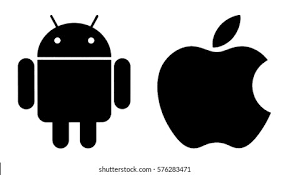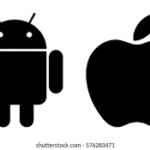The Enduring Appeal of the Android Logo Type: A Deep Dive into its Design and Evolution
Description: Explore the fascinating journey of the Android logo type, from its humble beginnings to its current iconic status. This article delves into the design philosophy, evolution, and cultural impact of the Android branding, including a look at how the Android vs Apple logo type philosophies differ, offering insights for anyone interested in brand identity and visual communication.
The Enduring Appeal of the Android Logo Type: A Deep Dive into its Design and Evolution
The digital landscape is dominated by symbols and icons that transcend language barriers, becoming instantly recognizable shorthand for complex technologies and global brands. Among these, the android logo type stands out – a playful yet potent symbol of the world’s most popular mobile operating system. Unlike the often sleek and minimalist approach of its competitors, the Android branding, particularly its Bugdroid mascot and associated typography, tells a story of openness, customization, and community. This article will dissect the android logo type, tracing its origins, analyzing its design elements, charting its evolution, and considering its place in the broader design world, especially when we look at the contrasting philosophies in the android vs apple logo type discussion.
I. The Genesis of the Android Logo Type: A Tale of Openness and Whimsy
The story of the android logo type begins not in a high-stakes corporate boardroom, but with a designer named Irina Blok. When Google was preparing to launch Android in 2007, Blok and her team were tasked with creating a visual identity. The key directive was that the logo should be open source, much like the Android platform itself. This crucial decision would shape not only the logo’s initial design but also its enduring legacy and widespread adoption.
Blok’s inspiration reportedly came from a simple source: the universal symbols for men and women found on restroom doors. She also drew inspiration from science fiction, particularly robots and androids. The aim was to create something simple, universally recognizable as a robot, and easily modifiable. The result was the “Bugdroid” – a friendly, green, robotic figure with a distinctively rounded body, antennaed head, and expressive eyes.
Initially, there wasn’t a strict, unified “logotype” or wordmark accompanying the Bugdroid. Early iterations saw various custom fonts, but the Bugdroid itself was the star. The decision to make the robot design open source was a masterstroke. It allowed developers, manufacturers, and enthusiasts to adapt, customize, and play with the Bugdroid, fostering a sense of community ownership and reinforcing the platform’s ethos of flexibility. This open approach is a significant differentiator when considering the android logo type in comparison to more tightly controlled brand identities.

II. Deconstructing the Android Logo Type: Key Elements and Their Significance
The android logo type as we understand it today is more than just the Bugdroid; it’s a combination of the mascot, the wordmark, and the signature color.
-
The Bugdroid: More Than Just a Robot
The Bugdroid is the heart of the Android visual identity. Its design is deceptively simple:-
Shape: A cylindrical torso with semi-circular dome head and limb segments. This makes it easy to render and recognize even at small sizes.
-
Features: Two simple dot eyes and two antennae. These minimal features give it a surprising amount of character – it can appear curious, friendly, or even mischievous depending on context or slight modifications.
-
Symbolism: It embodies the “android” concept literally but in a non-threatening, approachable way. It represents the technology, the platform, and the community. Its inherent customizability in early days mirrored the OS itself.
-
-
The Wordmark: The Evolution of “Android Logo Type” Typography
For a significant period, the “Android” wordmark was rendered in a custom, somewhat futuristic, sans-serif font. It often featured a slightly techy, almost pixelated feel in some earlier versions, like the “Droid” family of fonts (e.g., Droid Sans). The typography aimed to be modern and accessible.-
Early Wordmarks: These were often lowercase, emphasizing a friendly and less corporate feel. The typography was functional, clear, and designed to complement the Bugdroid.
-
2014 Redesign: With the advent of Material Design, the wordmark saw a subtle update, becoming cleaner and more aligned with Google’s broader design language. It was still typically lowercase “android.”
-
2019 Refresh: This was a more significant typographic shift for the android logo type. The wordmark changed to a new, custom sans-serif font that was softer, rounder, and more contemporary. The “n” and “r” had distinctive curves that echoed the Bugdroid’s form. The color palette also expanded beyond just green for the wordmark, often appearing in black or white for better contrast.
-
2023 Update: The most recent iteration saw the wordmark transition to an uppercase “Android,” signaling a potential shift towards a more mature and prominent brand statement. This change aligns it more closely with the “Google” logo’s capitalization, emphasizing its connection to the parent company. The font itself retained its modern, friendly curves but gained a bolder presence.
-
-
Android Green: The Signature Hue (#3DDC84)
The specific shade of green (hex code #3DDC84, often referred to as “Android Green”) is instantly synonymous with the brand. Green often connotes growth, vibrancy, nature, and sometimes, a touch of the unconventional. For Android, it provides a distinctive visual anchor that sets it apart from the blues, silvers, and grays common in tech branding. It’s a color that feels energetic and fresh, aligning with the platform’s dynamic and evolving nature. While the Bugdroid is almost always this green, the wordmark has seen more color flexibility in recent years.
III. The Evolution of the Android Logo Type: Adapting to a Changing Tech Landscape
The android logo type has not remained static. Its evolution reflects both changing design trends and Google’s strategic positioning of the Android brand.
-
Early Days (2007-2014): The Wild West of Bugdroid Customization
In its infancy, the Bugdroid was a symbol of freedom. Manufacturers and developers created countless variations – ninjas, astronauts, skateboarders – embedding the Bugdroid into their own branding. While this fostered community, it sometimes led to brand fragmentation. The accompanying android logo type (wordmark) was less consistently applied. -
The 2014 Redesign: Material Design and Unification
Coinciding with the launch of Android 5.0 Lollipop and Google’s new “Material Design” language, the Android branding received a refresh. The Bugdroid was subtly refined, with flatter shading and cleaner lines, aligning with Material Design’s principles. The wordmark became more standardized, often in a lighter weight and lowercase. The overall android logo type felt more cohesive and modern. -
The 2019 Refresh: Modernizing and Expanding the Brand
This was a significant visual overhaul. The Bugdroid’s head was often featured more prominently, sometimes detached from its body, making it more versatile as an icon. The green color was slightly tweaked to be more accessible, and a new, softer, curvier wordmark was introduced for “android.” The color palette for branding elements expanded, allowing for more flexibility beyond just green and white/black. This iteration aimed to make the android logo type more contemporary and adaptable across various touchpoints. -
The 2023 Update: 3D Bugdroid and Capitalized “Android”
The latest evolution, rolled out in 2023, brought back a more dimensional, 3D look for the Bugdroid, giving it more texture and personality. It can now appear in various finishes and even dynamic forms. Perhaps the most notable change was the shift in the wordmark to an initial capital “A” – “Android.” This makes the android logo type feel more like a proper noun, a distinct brand name on par with “Google.” The font shares similarities with the one used for Google’s logo, creating a stronger visual link between the OS and its parent company. This move suggests a maturation of the brand, presenting a more assertive and unified front.
IV. Android vs Apple Logo Type: A Study in Contrasting Philosophies
No discussion of mobile OS branding is complete without considering the android vs apple logo type comparison. The differences are stark and reflect the core philosophies of each company:
-
-
Design: The iconic bitten apple. It’s sleek, minimalist, and sophisticated. The typography associated with Apple (historically variants of Garamond, Myriad, and now San Francisco) is clean, highly legible, and often understated, letting the products and the core apple mark shine.
-
Philosophy: Represents simplicity, elegance, a curated experience, and a premium, closed ecosystem. The logo is tightly controlled, rarely (if ever) modified, and universally applied. It signifies quality, design leadership, and a certain exclusivity.
-
Symbolism: The bite can be interpreted in many ways – a nod to knowledge (Tree of Knowledge), a play on “byte,” or simply a way to distinguish it from a cherry. Its strength lies in its timeless simplicity and unchanging nature.
-
-
Android Logo Type:
-
Design: The playful Bugdroid and an evolving, friendly wordmark. The overall feel is approachable, customizable, and tech-forward without being intimidating.
-
Philosophy: Represents openness, choice, customization, and a vast, diverse ecosystem. The history of allowing modification to the Bugdroid (though more controlled now) speaks volumes about its community-driven and flexible nature.
-
Symbolism: The Bugdroid clearly signifies “android” and “robot,” directly referencing the OS’s nature. Its green color suggests vibrancy and growth. The evolving nature of the android logo type reflects the dynamic and ever-improving platform.
-
The android vs apple logo type discussion highlights two successful but fundamentally different approaches to branding. Apple opts for timeless consistency and premium minimalism, while Android embraces a more dynamic, approachable, and historically open identity. Both are incredibly effective for their respective target audiences and brand strategies.
V. The Impact and Recognition of the Android Logo Type
The android logo type, particularly the Bugdroid, has achieved remarkable global recognition. Its presence on billions of devices worldwide has made it one of the most ubiquitous tech symbols.
-
Brand Association: It instantly signals the Android operating system, its features, and its vast app ecosystem.
-
Community Engagement: Even with tighter brand controls now, the Bugdroid’s legacy of openness has fostered a strong community. Enthusiasts still create fan art and custom interpretations, showcasing affection for the brand.
-
Adaptability: The design, especially the Bugdroid, is versatile. It works well on screens, in print, as physical statues (like those at Google HQ), and in merchandise. The recent 3D evolution further enhances this adaptability.
-
Friendly Face of Technology: In a world where technology can often feel cold or complex, the Bugdroid provides a friendly, accessible face, making the powerful Android OS feel more approachable.
The journey of the android logo type is a testament to the power of thoughtful design combined with a philosophy that resonates with its user base. Its evolution shows a brand maturing alongside its platform, adapting to new design trends while retaining its core identity.
VI. Conclusion: The Lasting Legacy of the Android Logo Type
The android logo type is far more than just a corporate mark; it’s a cultural icon. From Irina Blok’s open-source Bugdroid to the latest 3D iteration and capitalized wordmark, its journey mirrors the evolution of the Android operating system itself – a path of growth, adaptation, and increasing sophistication while striving to maintain an approachable and open core.
The deliberate choice of a friendly robot, the distinctive green, and the evolving typography have collectively created a powerful and recognizable brand identity. While the android vs apple logo type comparison reveals distinct philosophies, the success of the android logo type lies in its unique ability to represent a complex technological ecosystem with a sense of playfulness and community. As Android continues to evolve, its logo type will undoubtedly adapt with it, but the friendly green Bugdroid and its associated branding have already cemented their place in the annals of iconic design. The strength of the android logo type is a key factor in the platform’s global dominance and enduring appeal.









